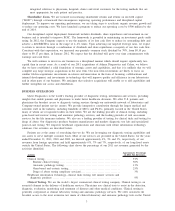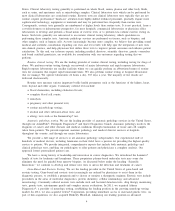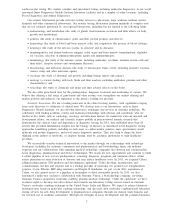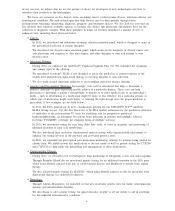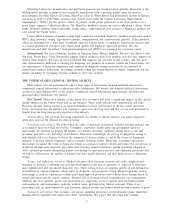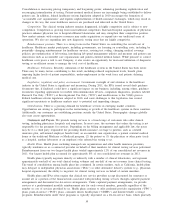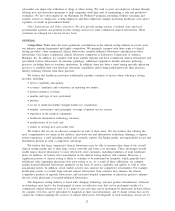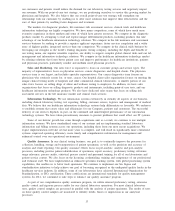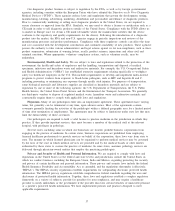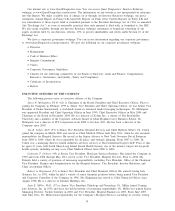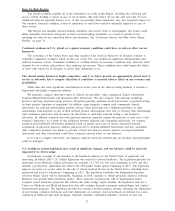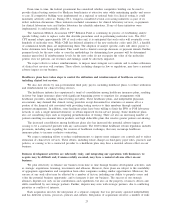Quest Diagnostics 2011 Annual Report Download - page 19
Download and view the complete annual report
Please find page 19 of the 2011 Quest Diagnostics annual report below. You can navigate through the pages in the report by either clicking on the pages listed below, or by using the keyword search tool below to find specific information within the annual report.our customers and patients would reduce the demand for our laboratory testing services and negatively impact
our revenues. With our point-of-care test strategy, we are positioning ourselves to service this growing market for
physicians and hospitals. We also believe that our overall point-of-care test strategy will strengthen our
relationship with our customers by enabling us to offer more solutions that improve their effectiveness and the
care of their patients by enabling faster diagnosis and treatment.
The markets for diagnostic products, life insurance risk assessment services, clinical trials and healthcare
information technology are highly competitive. We have many competitors, some of which have much more
extensive experience in these markets and some of which have greater resources. We compete in the diagnostic
products market by attempting to find and exploit unique differentiated products, including products that take
advantage of our healthcare information technology solutions. We compete in the life insurance risk assessment
services business by seeking to provide a superior applicant experience, faster services completion and a wider
array of highest quality, integrated services than our competitors. We compete in the clinical trials business by
leveraging our strengths as the world’s leading diagnostic testing company, including the depth and breadth of
our testing menu, our superior scientific expertise, our ability to support complex global clinical trials and our lab
management and information technology solutions. We compete in the healthcare information technology market
by offering solutions that foster better patient care and improve performance for healthcare institutions, patients
and physician practices, particularly smaller and medium sized physician practices.
Sales and Marketing. Our sales force is organized to focus on customer groups and service types. The
majority of representatives focus on physician services, cancer diagnostics and hospital clients. The physician
services team is our largest, and includes specialty representatives. Our cancer diagnostics team focuses on
physicians who routinely screen for, or treat, cancer. Our hospital client sales organization focuses on meeting the
unique clinical testing needs of hospitals and other commercial clinical laboratories. A smaller portion of our
sales force focuses on selling drugs of abuse and wellness testing to employers. In addition, we have sales
organizations that focus on selling diagnostic products and instruments, including point-of-care tests, and our
healthcare information technology products. We also have dedicated sales teams that focus on selling risk
assessment services in the life insurance market and clinical trials services.
Information Technology. We use information systems extensively in virtually all aspects of our business,
including clinical laboratory testing, test reporting, billing, customer service, logistics and management of medical
data. We believe that our healthcare information technology systems help differentiate us favorably. We endeavor
to establish systems that create value and efficiencies for our Company, patients and customers. The successful
delivery of our services depends, in part, on the continued and uninterrupted performance of our information
technology systems. We have taken precautionary measures to prevent problems that could affect our IT systems.
Some of our historic growth has come through acquisitions and, as a result, we continue to use multiple
information systems. We have standardized some of our systems and are implementing standard laboratory
information and billing systems across our operations, including those from our most recent acquisitions. We
expect implementation will take several more years to complete, and will result in significantly more centralized
systems, improved operating efficiency, more timely and comprehensive information for management and
enhanced control over our operational environment.
Quality Assurance. In our clinical testing business, our goal is to continually improve the processes for
collection, handling, storage and transportation of patient specimens, as well as the precision and accuracy of
analysis and result reporting. Our quality assurance efforts focus on pre-analytic, analytic and post-analytic
processes, including positive patient identification of specimens, report accuracy, proficiency testing, reference
range relevance, process audits, statistical process control and personnel training for all of our laboratories and
patient service centers. We also focus on the licensing, credentialing, training and competence of our professional
and technical staff. We have implemented an enhanced specimen tracking system, with global positioning system
capabilities, that enables us to better track specimens. We continue to implement our Six Sigma and
standardization initiatives to help achieve our goal of becoming recognized as the undisputed quality leader in the
healthcare services industry. In addition, some of our laboratories have achieved International Organization for
Standardization, or ISO, certification. These certifications are international standards for quality management
systems. In 2011, we continued to take steps to enhance our quality assurance program.
As part of our comprehensive quality assurance program, we utilize internal proficiency testing, extensive
quality control and rigorous process audits for our clinical laboratory operations. For most clinical laboratory
tests, quality control samples are processed in parallel with the analysis of patient specimens. The results of tests
on these quality control samples are monitored to identify trends, biases or imprecision in our analytical
processes.
13


